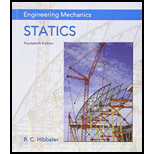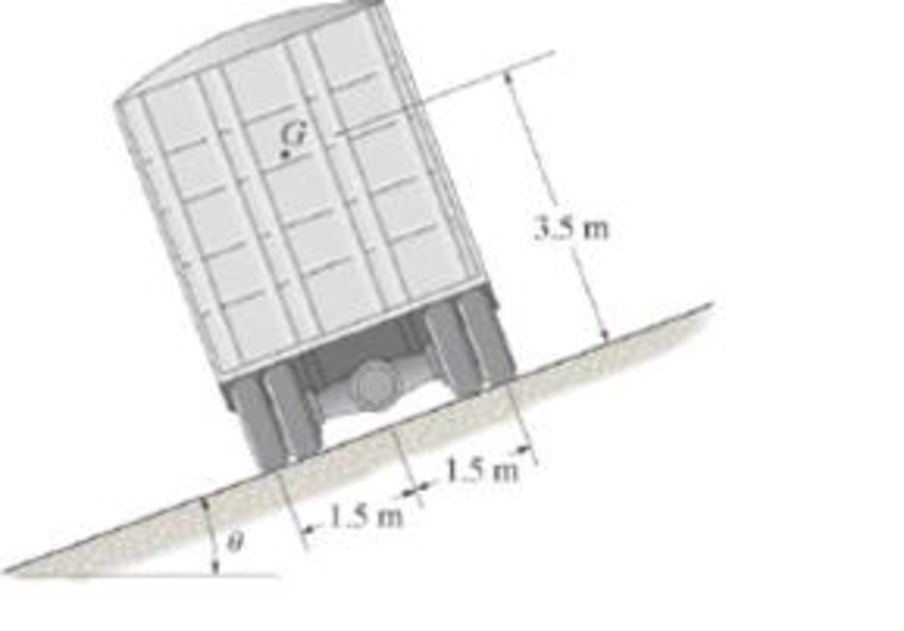
Engineering Mechanics: Statics and Modified Mastering Engineering with eText and Access Card (14th Edition)
14th Edition
ISBN: 9780134229287
Author: Russell C. Hibbeler
Publisher: PEARSON
expand_more
expand_more
format_list_bulleted
Concept explainers
Textbook Question
Chapter 11.7, Problem 43P
Determine the steepest grade θ along which it can park without overturning and investigate the stability in this position.

Expert Solution & Answer
Want to see the full answer?
Check out a sample textbook solution
Students have asked these similar questions
5. A 4000 lb block of concrete is attached by light inextensible cables to the truss in Figure 5.
Determine the force in each member. State whether each member is in tension or compression.
3
ΘΑ
D
E
cables
all dimensions in feet.
A block hangs from the end of bar AB that is 5.80 meters
long and connected to the wall in the xz plane. The bar is
supported at end A by a ball joint such that it carries only a
compressive force along its axis. The bar is supported in
equilibrium at end B by cables BD and BC that connect to
the xz plane at points C and D respectively with
coordinates given in the figure. The z components of the
moments exerted on the bar by these two cables sum to 0.
The tension in cable BD is measured to be 210 Newtons.
Input answers of zero as 0.00 to avoid an invalid answer due
to significant figures.
Determine the equivalent force and couple system acting at
A that models only the forces exerted by both cables BD
→
and BC on the bar at B. Enter your results for Feq and Meg
in Cartesian Components.
Z
D
(c, 0, d)
C
(a, 0, b).
X
A
f
m
B
y
cc 040
BY NC SA
2016 Eric Davishahl
Values for dimensions on the figure are given in the following
table. Note the figure may not be to scale.
Variable Value
a…
A bent tube is attached to a wall with brackets as shown. A
force of F = 785 lb is applied to the end of the tube with
direction indicated by the dimensions in the figure.
a.) Determine the moment about point D due to the force F
Enter your answer in Cartesian components with units of ft-
lbs.
b.) Determine the moment about a line (i.e. axis) running
from D to C due to the force F. Enter your answer in
Cartesian components with units of ft-lbs.
2013 Michael Swanbom
x
BY NC SA
g
Z
h
A
с
FK
kaz
Values for dimensions on the figure are given in the table
below. Note the figure may not be to scale. Be sure to align
your cartesian unit vectors with the coordinate axes shown in
the figure.
Variable Value
α
4.84 in
b
13.2 in
с
12.5 in
d
30.8 in
h
18.7 in
22.0 in
→>
a. MD=(
i+
k) ft-
lb
→>
b. MDC =
î +
k) ft-
lb
Chapter 11 Solutions
Engineering Mechanics: Statics and Modified Mastering Engineering with eText and Access Card (14th Edition)
Ch. 11.3 - Each link has a mass of 20 kg.Ch. 11.3 - Determine the magnitude of force P required to...Ch. 11.3 - Determine the angle for equilibrium. The spring...Ch. 11.3 - Determine the angle for equilibrium. The spring...Ch. 11.3 - Prob. 5FPCh. 11.3 - Determine the angle for equilibrium. The spring...Ch. 11.3 - The lamp weighs 10 lb.Ch. 11.3 - Each of the four links has a length L and is pin...Ch. 11.3 - Determine the force screw exerts on the cork of...Ch. 11.3 - Determine the disks rotation if the end of the...
Ch. 11.3 - Prob. 5PCh. 11.3 - Prob. 6PCh. 11.3 - if the uniform inks AB and CD each weigh 10 lb....Ch. 11.3 - If the unstretched length of the spring is I0,...Ch. 11.3 - It vertical forces P1 = P2 = 30 lb act at C and E...Ch. 11.3 - Prob. 10PCh. 11.3 - The spring which always remains vertical. Is...Ch. 11.3 - Prob. 12PCh. 11.3 - Prob. 13PCh. 11.3 - Prob. 14PCh. 11.3 - Prob. 15PCh. 11.3 - Prob. 16PCh. 11.3 - Prob. 17PCh. 11.3 - Determine the angle for equilibrium. The spring...Ch. 11.3 - Determine the stillness k of the spring for...Ch. 11.3 - Determine the horizontal compressive force F...Ch. 11.3 - Prob. 21PCh. 11.3 - Prob. 22PCh. 11.3 - The lever is in balance when the load and block...Ch. 11.3 - If the load F weighs 20 lb and the block G weighs...Ch. 11.3 - Determine the force in the hydraulic cylinder...Ch. 11.7 - Determine the equilibrium positions and...Ch. 11.7 - Prob. 27PCh. 11.7 - If the potential function for a conservative...Ch. 11.7 - Prob. 29PCh. 11.7 - Prob. 30PCh. 11.7 - The rod BD, having negligible weight, passes...Ch. 11.7 - Determine the angle for equilibrium when a weight...Ch. 11.7 - Determine the angle for equilibrium and...Ch. 11.7 - Prob. 34PCh. 11.7 - Prob. 35PCh. 11.7 - The bars each have a mass of 3 Kg one the...Ch. 11.7 - The bars each have a mass of 10 kg and the spring...Ch. 11.7 - Determine the required stiffness k of the spring...Ch. 11.7 - It is unstretched when the rod assembly is in the...Ch. 11.7 - Determine the minimum distance d in order for it...Ch. 11.7 - If the spring is unstretched when = 60. Determine...Ch. 11.7 - The contact at A is smooth, end both are pm...Ch. 11.7 - Determine the steepest grade along which it can...Ch. 11.7 - Determine the weight W2, that is on the pan in...Ch. 11.7 - If the rod is supported by a smooth slider block...Ch. 11.7 - Point C is coincident with B when OA is...Ch. 11.7 - Prob. 47PCh. 11.7 - Prob. 48PCh. 11.7 - If the block has three equal sides of length d,...Ch. 11.7 - Prob. 1RPCh. 11.7 - Determine the horizontal force P required to hold...Ch. 11.7 - Prob. 3RPCh. 11.7 - Prob. 4RPCh. 11.7 - Prob. 5RPCh. 11.7 - Prob. 6RPCh. 11.7 - If both spring DE and BC are unstretched when =...Ch. 11.7 - Prob. 8RP
Knowledge Booster
Learn more about
Need a deep-dive on the concept behind this application? Look no further. Learn more about this topic, mechanical-engineering and related others by exploring similar questions and additional content below.Similar questions
- F1 3 4 5 P F2 F2 Ꮎ e b 200 3 4 5 F1 The electric pole is subject to the forces shown. Force F1 245 N and force F2 = 310 N with an angle 0 = 20.2°. Determine the moment about point P of all forces. Take counterclockwise moments to be positive. = Values for dimensions on the figure are given in the following table. Note the figure may not be to scale. Variable Value a 2.50 m b 11.3 m с 13.0 m The moment about point P is m. N- If the moment about point P sums up to be zero. Determine the distance c while all other values remained the same. m.arrow_forwardF y b C 10 Z Determine the moment about O due to the force F shown, the magnitude of the force F = 76.0 lbs. Note: Pay attention to the axis. Values for dimensions on the figure are given in the following table. Note the figure may not be to scale. Variable Value a 1.90 ft b 2.80 ft с 2.60 ft d 2.30 ft Mo = lb + k) ft-arrow_forwardThe shelf bracket is subjected to the force F = 372 Newtons at an angle = 21.4°. Compute the moment (in N-m) that this force exerts about each of the two attachment points (screw locations in the figure). Take counterclockwise moments to be positive. a duk F -0 2013 cc Michael Swanbom BY NC O SA Values for dimensions on the figure are given in the following table. Note the figure may not be to scale. Variable Value a 43.0 cm b 32.3 cm с 2.58 cm The moment about the upper attachment point is N-m. The moment about the lower attachment point is N-m.arrow_forward
- A man skis down a slope. His initial elevation was 150 m and his velocity at the bottom of the slope is 17 m/s. What percentage of his initial potential energy was consumed due to friction and air resistance? Use the accounting equation in your calculations.arrow_forwardIn direct calorimetry, a person is placed in a large, water-insulated chamber. The chamber is kept at a constant temperature. While in the chamber, the subject is asked to perform a number of normal activities, such as eating, sleeping, and exercising. The rate of heat released from the subject’s body can be measured by the rate of heat gain by the water bath. Would direct calorimetry be a practical way to measure metabolic rate? Why or why not?A person is placed inside a calorimetric chamber for 24 hours. During this time, the 660-gallon water bath heats up by 3.2°F. What is the subject’s metabolic rate during this period? Report your answer in kcal/day. Assume that there is no heat loss from the water to the surroundings.arrow_forwardUpon reentry into the Earth’s atmosphere, the bottom of a space shuttle heats up to dangerous levels as the craft slows for landing. If the velocity of the shuttle is 28,500 km/hr at the beginning of reentry and 370 km/hr just prior to landing, how much energy is lost as heat? The shuttle has a mass of 90,000 kg. Assume that the change in potential energy is negligible compared to the change in kinetic energy.arrow_forward
- of the basket of the balloon at point A, and their other ends are staked to the ground. The hook is located in the geometric center of the basket. The balloon and the air inside it have a combined mass of 3000 kg. You want to determine the resultant of the tension forces in the four cables acting on the hook at point A. It is known that the magnitudes of the tension in the cables are as follows: TAB = 207 N; TAC = 355 N; TAD = 250 N; and TAE = 486 N. B E 2.5 m C E 5.5 m D 2.5 m 3.5 m 1.5 m Using the information provided in the problem, express the force on the hook at point A by cable AC in rectangular component form. The force on the hook at point A by cable AC in rectangular component form is given below. T AC N) i+ N) + N) Rarrow_forwardWater in the glass tube is at a temperature of 40°C. Plot the height of the water as a function of the tube's inner diameter D for 0.5mm≤D≤3mm. Use increments of 0.5mm. Take sigma=69.6mN/m, and theta=0° for the contact angle.arrow_forwardDetermine the distance h that the column of mercury in the tube will be depressed when the tube is inserted into the mercury at a room temperature of 68 F. Plot this relationship of h (vertical axis) versus D for 0.5 in≤D≤0.150in. Give values for increments of ΔD=0.025in. Discuss this resultarrow_forward
- Water is at a temperature of 30 C. Plot the height h of the water as a function of the gap w between the two glass plates for 0.4 mm ≤ w ≤ 2.4 mm. Use increments of 0.4mm. Take sigma=0.0718 N/m.arrow_forwardWhat is the reading on the vernier calipers? 7 6 0 5 10 8arrow_forwardDetermine the moments of the force about the x and the a axes. O 4 m F = {-40i +20j + 10k} N 3 m 6 m aarrow_forward
arrow_back_ios
SEE MORE QUESTIONS
arrow_forward_ios
Recommended textbooks for you
 International Edition---engineering Mechanics: St...Mechanical EngineeringISBN:9781305501607Author:Andrew Pytel And Jaan KiusalaasPublisher:CENGAGE L
International Edition---engineering Mechanics: St...Mechanical EngineeringISBN:9781305501607Author:Andrew Pytel And Jaan KiusalaasPublisher:CENGAGE L

International Edition---engineering Mechanics: St...
Mechanical Engineering
ISBN:9781305501607
Author:Andrew Pytel And Jaan Kiusalaas
Publisher:CENGAGE L
Chemical and Phase Equilibrium; Author: LearnChemE;https://www.youtube.com/watch?v=SWhZkU7e8yw;License: Standard Youtube License